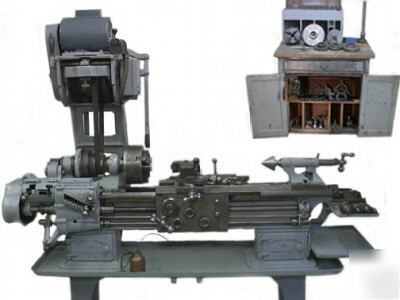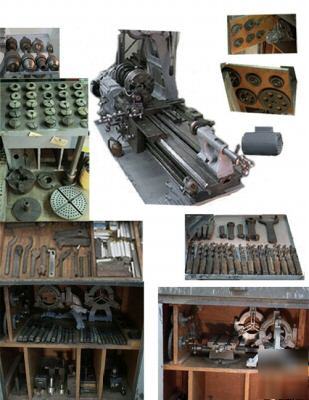 Up
Up
|
Hardinge Cataract Quick Change Swing Precision Lathe Designed by Mr. Franklin Hardinge and in production for the first time during World War 1 (1914 -1918) the fabulous Hardinge 9" x 28" "Cataract Quick Change Swing Precision Lathe" was a new departure for the company. The specification was excellent with a 21/32-inch diameter front headstock bearing and a hardened and ground 1.25" bore spindle; a full screwcutting gearbox drove a 1-inch diameter 6 tpi leadscrew with a separate powershaft for the standard-fit power sliding and surfacing (both engaged by friction clutches) with an automatic, precision-adjustable disengagement to the sliding feed; extremely long saddle wings - which overlapped the headstock by several inches - taper turning as standard, a 360 degree swivel top, twin-clamp tailstock and a useful swing-out rotating collet tray beneath the chip tray. The power feeds could be instantly changed through three rates by a separate control working through the gearbox input gears. As standard the lathe's capacity was, considering the enormous depth, width and weight of the bed, very modest but, as its name implied ("Quick Change Swing"), it was possible to make better use of its strength and order a set of raiser blocks for headstock, tailstock and toolpost that took the center height from 4.5 to a more useful 7.5 inches. These blocks were missing from an example owned by the Author some time ago (date stamped 1917), a machine that had been standing neglected for many years; although superficially in poor order, the quality shone through and with just a thorough cleaning, careful oiling and attention to the main adjustments it was successfully restored to active duty. This antique lathe has been in my family for over 40 years. My family owned a factory that manufactured the Air Compression Systems for the Oil and Power Industry so this lathe was restored by expert machinist back in the early 1960's. Needless to say this was my fathers first lathe, which he kept at our house. It has always been garaged and serviced, which has kept it in great condition. Many extras including a spare motor, bits, stop for saddle, chuck and many more. |

